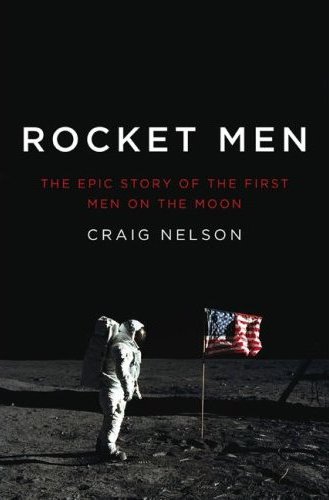
Rocket Men: The Epic Story of the First Men on the Moon
by Craig Nelson
-Reviewed by Jodie Liu
When Apollo 11 launched from Kennedy Space Center on July 16, 1969, it had been a decade in the making, a $29.5 billion mission requiring six million instrument parts and 300,000 hands. Neil Armstrong and Buzz Aldrin landed on the moon four days later, kicking up a swirl of lunar soil on the moon and a storm of media frenzy on Earth.
But what most didn’t know, as Craig Nelson reveals in Rocket Men, is that NASA’s mission to put man on the moon could be attributed just as much to eleventh hour improvisation as to the decade of fastidious preparation. Only a month before the scheduled launch date, Apollo program director Lt. Gen. Samuel C. Phillips called an impromptu meeting to review the general specifics of the mission, providing him a final opportunity to postpone its scheduled launch date. This was only one of the many last-minute close calls that might have nixed the entire mission.
Forty years after Apollo 11’s momentous moon landing, Nelson narrates the gripping drama and personalities behind Apollo 11’s flashy media coverage. Few Americans under the age of 40, for instance, would recognize the name Mike Collins, who was the third astronaut (along with Neil Armstrong and Buzz Aldrin) to man the moon-landing mission but who remained in orbit around the moon while Armstrong and Aldrin floated down to the surface. Nelson also verifies strains between Armstrong, the most reticent of the trio, and Aldrin, the most candid; and explains how Aldrin, not Armstrong, might have gone down in history as the first man on the moon. Apollo 11 also marked the “birth of the moon,” Nelson writes, as Armstrong and Aldrin collected first hand-selected samples of lunar material to be brought back to earth and analyzed in laboratories. These samples divulged that the Moon had the same isotope ratios as Earth, a similarity which prompted the first leading hypothesis of the moon’s origin.
Nelson reminds us that Apollo 11’s mark as mankind’s single most awe-inspiring achievement has yet to be matched. In doing so, Nelson renews the charge to continue reaching for the stars – and if we fall, at least we’ll land on the moon.
Excerpt: For all of human history, the lunar surface has remained the same, and this condition reminds us how alive the Earth really is in the weather of its atmosphere, the tides of its seas, the seasons of its tilting axes, and the geology of its volcanoes, tectonic plates, and erosion.
We think of the Earth and the Moon as round, but the Earth is somewhat pear-shaped, while the Moon is something like a vertical football. We think of their paring as eternal, but every year, the Moon moves 1.5 inches away from the Earth. The crust on the MOon’s near side, which always faces the Earth, is much thinner than the far side, which has far fewer plains of maria and far more craters. It is now believed that water ice may exist in deep craters at the lunar poles, and NASA will one day send a reconnaissance drone into lunar orbit to see if this is so….
Further Reading: Voices from the Moon: Apollo Astronauts Describe Their Lunar Experiences and Magnificent Desolation: The Long Journey Home from the Moon




Send A Letter To the Editors